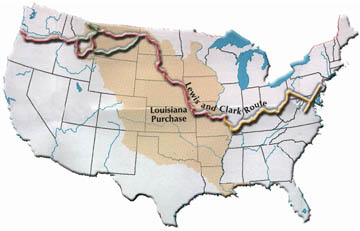|
|
Canku Ota |
|
|
(Many Paths) |
||
|
An Online Newsletter Celebrating Native America |
||
|
March 6, 2004 - Issue 108 |
||
|
|
||
|
Lewis and Clark -- A View from the Riverbank |
||
|
by Dorreen Yellow Bird - Grand
Forks (ND) Herald
|
||
|
credits: graphic:
The route Lewis and Clark followed across the continent.
|
|
This week, I went to Bismarck, Hurdsfield and Velva, N.D., to talk to students about the American Indian perspective of that historic journey. Most of the lessons the students are learning are based on the journals of Lewis and Clark and from a non-Indian perspective. In my talks, I tried to give the other point of view. There is something energizing about talking with young people, especially kindergartners and first-graders. They are wide-open to new ideas and will ask the most pointed questions. The classes ranged from kindergarten to sixth grade. What I hoped would happen is that in their minds, they would stand on the cliffs above the Missouri River among the earth lodges and watch Lewis and Clark's crew paddling upriver in their three boats. I wanted the children to see things from the Indian point of view of 200 years ago. Most knew their lessons well. They had studied and were interested in everything from what happened to Lewis and Clark after they returned from their historic journey to the name of Sakakawea's son. I have read Lewis and Clark's journals in sections and cover to cover several times, because I've also worked on the history of the Arikara or Sahnish people. Lewis and Clark stopped at the Arikara villages for a few days before they moved on to the Mandan and Hidatsa (called Gros Ventre) villages. It was important to me that the children understand that the journals' sometimes derogatory remarks about Indians had another side. As the Indian people stood and watched the crew come up the river, surely some of the young children ran and hid behind their mothers in terror at the sight of the white men. Here was a group of travelers with white or sunburnt red skin. Those Indian children would have grown up around people with mostly brown skin, although there were some white traders who lived with the tribes. Many of the young children never had seen people with hair on their faces such as beards or mustaches. In some of the oral traditions, it is said they thought the crew might be related to animals because of their hairy faces. Red and blond hair was, of course, unusual to people who have straight black hair. The youngsters didn't quiet see that until I told them to stand on the shore and see the crew with green or purple hair. They laughed and giggled. I spoke mostly about the Arikara (as they called us then), the Mandan and the Hidatsa because I know them best. I told the students that the tribes traded with Lewis and Clark. The explorers gave the tribes small mirrors, beads, kettles and the like; the tribes traded furs and food. The tribes were good farmers who raised vegetables such as corn, squash, pumpkins, watermelons, sunflowers and other produce that Lewis and Clark never had tasted. The crew came out ahead in the transactions, I believe. It was important to me that the children understand that there is more than one point of view; for example, while Lewis and Clark's crew saw "savages," the Indian people saw the same. I wanted the students to see the story while standing in the Indians' moccasins. Lewis and Clark weren't as destructive as other traders and explorers. Still, their perspective that Native people were just a cut above uncivilized was common among those who came up the river. Finally, for me, it was important to leave the students with the thought that we need to look beyond skin color. A person is more than their color. We have a spirit. It is important than we respect all people because we all are related. The children were good listeners. I give credit also to the staff and teachers who wanted their young people to hear about Lewis and Clark from that other perspective. |
|
|
www.expedia.com |
|
|
||
|
|
||
| Canku Ota is a free Newsletter celebrating Native America, its traditions and accomplishments . We do not provide subscriber or visitor names to anyone. Some articles presented in Canku Ota may contain copyright material. We have received appropriate permissions for republishing any articles. Material appearing here is distributed without profit or monetary gain to those who have expressed an interest. This is in accordance with Title 17 U.S.C. Section 107. | ||
|
Canku Ota is a copyright © 2000, 2001, 2002, 2003, 2004 of Vicki Lockard and Paul Barry. |
||
 |
 |
|
|
The "Canku Ota - A Newsletter Celebrating Native America" web site and its design is the |
||
|
Copyright © 1999, 2000, 2001, 2002, 2003, 2004 of Paul C. Barry. |
||
|
All Rights Reserved. |
||
 North
Dakota is smack dab in the middle of the 200th anniversary of the
Lewis and Clark expedition. This is especially true in western North
Dakota and along the Missouri River in cities such as Bismarck.
People there are following some of the same footprints walked by
the Corps of Discovery.
North
Dakota is smack dab in the middle of the 200th anniversary of the
Lewis and Clark expedition. This is especially true in western North
Dakota and along the Missouri River in cities such as Bismarck.
People there are following some of the same footprints walked by
the Corps of Discovery.  insert
map here
insert
map here